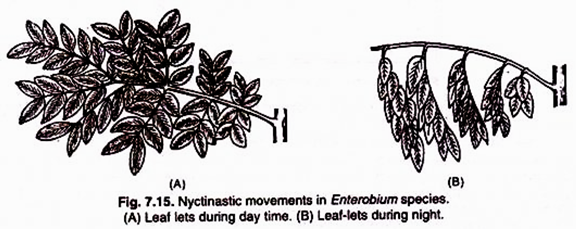The following points highlight the top seven types of drugs obtained from leaves. The types are: 1. Vasaka 2. Indian Aloe 3. Life Plant 4. Indian Pennywort 5. Holy Basil 6. Betel Pepper 7. Tylophora.
Type # 1. Vasaka:
Adhatoda vasica Nees., of family Acanthaceae; Eng. Malabo nut; Verna—Amsi, rusa.
This is a perennial shrub. An evergreen shrub about 4-8 feet in height. Leaves elliptic, lanceolate, acuminate, dark green above, pale beneath. Flowers in short dense-axillary peduncled spikes, white with pink or purple stripes. Flowers after rainy season.
It is found throughout the plains of India and in the sub-Himalayan tract up to 4,000 feet.
Twigs and flowers of the plants are collected in March-April. The dried drug is sold in the market.
Uses:
The leaves contain the alkaloid vascine; they are a powerful expectorant and antispasmodic; they are commonly used in chest diseases, especially phthisis. A decoction of the leaves or their powder is also given, especially for chronic bronchitis and asthma. The leaf juice is given in diarrhoea and dysentery.
The leaves are given as a febrifuge in malarial fevers. For relief of asthma the dried leaves are smoked. A poultice of the leaves is applied over fresh wounds, rheumatic joints and inflammatory swellings. A warm decoction of the leaves is used for scabies and other skin diseases.
The flowers and fruits are bitter, aromatic and antispasmodic.
The root is expectorant, antispasmodic, antiseptic, antiperiodic and anthelmintic. It is given in malarial fevers, diseases of the respiratory system, diphtheria and gonorrhoea. The root and the bark have the same medicinal uses as the leaves.
The preparations are—Vansa Khand and Chyavanprash.
Type # 2. Indian Aloe:
Aloe barbedensis Mill., of family Liliaceae; Eng. Indian Aloe; Verna. Gheekunvar, ghrita kumari.
The plant is about 2-3 feet high. The leaves are fleshly tapering to a blunt point, smooth, pale green, having horny prickles on their margins. The plant is found throughout our country.
Uses:
After removing the skin of leaves they are given in fevers, enlargement of the liver, spleen and other glands, skin diseases, gonorrhoea, constipation, menstrual suppression, piles, jaundice and rheumatic affections. In the diseases of liver and spleen the pulp of one leaf is administered with black salt and ginger. The juice of roasted leaf is being given with honey for cough and cold.
The pulp of one leaf is being given daily in abdominal tumors, dropsy, carbuncles, piles, sciatica, rheumatism and retention of urine in fevers. A salad of leaves is eaten in indigestion, constipation and flatulence. The leaf juice is given as a remedy for intestinal worms in children. A poultice of the leaves is applied to tumours, cysts, inflamed parts and scalds.
Type # 3. Life Plant:
Bryophyllum pinnatum Kurz., of family enlargement Crassulaceae; Eng. Life plant; Hindi—Ghaawan.
This is a succulent perennial plant. Distributed throughout India.
Uses:
The leaf juice is given in diarrhoea, dysentery, calculous affections and cholera. The leaves are styptic, astringent and antiseptic; they are slightly toasted before they are applied to wounds, bruises, boils, cuts, ulcers, bites of venomous insects; by its application swelling is prevented, incised wounds heal rapidly and irritation is allayed.
Type # 4. Indian Pennywort:
Centella asiatica (L.) Urban., of family Umbelliferae (Apiaceae); Eng. Indian pennywort; Hindi—Brahmi.
This is a common trailing herb, rooting at the nodes. Commonly found throughout India.
Uses:
The weed is alterative, tonic, diuretic, antiphlogistic, blood purifier and local stimulant. It is a remedy for skin diseases, like chronic eczema, chronic ulcers etc., enlargement of glands, chronic rheumatism, chronic nervous diseases, madness, cholera, amenorrhoea and piles. The leaves are a household remedy in early stages of dysentery of children.
The powder of leaves is given with milk in small doses in mental weakness and to improve memory. The fresh juice of leaves mixed with milk is given as an alternative in gonorrhoea, jaundice and fevers; this is also useful for children in skin diseases and for improving the blood and nervous system. An ointment made of leaf juice and lanoline is of great value in elephantiasis.
Type # 5. Holy Basil:
Ocimum sanctum Linn., of family Labiatae; Eng. Holy basil; Hindi—Tulsi.
This is an erect softy hairy aromatic herb or undershrub. Found throughout India.
Uses:
The leaves are expectorant, stomachic, anticatarrhal, diaphoretic and aromatic; their decoction or infusion is given in malaria, gastric diseases of children and liver disorders; as a prophylactic against malaria fresh leaves are taken with black pepper in the morning. The leaf juice is given in chronic fever, haemorrhage dysentery and dyspepsia; it is also used to check vomiting and as an anthelmintic.
Type # 6. Betel Pepper:
Piper betel Linn., of family Piperaceae; Eng. Betel pepper; Hindi—Pan.
This is a climbing shrub cultivated for its leaves.
Uses:
The leaves are astringent, aromatic, antiseptic, carminative, aphrodisiac, stimulant, expectorant and sialogogue. The leaf juice with honey is given to children in colic, indigestion, diarrhoea and laryngitis. The leaves are chewed to remove foul odour from the mouth.
The leaf juice is used as eye drops in ophthalmia, and other painful eye diseases and night blindness. Oil coated leaves are a useful dressing for blistered surfaces and ulcers. The essential oil extracted from the leaves, is given in catarrhal and pulmonary diseases.
Type # 7. Tylophora:
Tylophora asthmatica; Syn. Tylo-phora indica; Hindi―Jangli Pikavan or Antamul; Family—Asclepiadaceae.
It is a trailing creeper, growing abundantly in Northern India, Bengal, Assam; the Western Ghats. Burma and Sri Lanka. The leaves are thick and deep green, 5 to 12 cm long and 2 to 6 cm wide. In dry state, they are rather, thick and of a pale-yellow colour.
Uses:
The chewing and swallowing of leaves by the patient of asthma have shown wonderful results. The leaf was also tried at Vallabhbhai Patel Chest Institute, Delhi on the patients suffering from bronchial asthma, the results were quite satisfactory.




